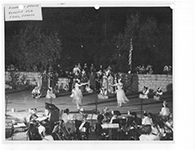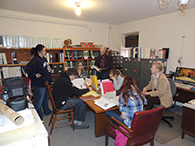University journalism class helps reconnect towns in Kansas and France
Thursday, Dec. 12, 2013
MANHATTAN -- A small town in Kansas and one in France are reconnecting thanks, in part, to a Kansas State University journalism and mass communications class assignment.
Students in Gloria Freeland's News and Feature Writing classes wrote stories about communities in nearby Clay County as their final project for the spring 2013 semester. One story about the connection between Morganville, Kan., and Fèves, France, has led to re-establishing ties between the two towns.
In 1947, Morganville, population of less than 300, wanted to aid a village devastated by World War II. The town adopted Fèves, a small farming community in the Moselle Valley of France's Lorraine region. Their story was broadcast on the NBC radio network and Armed Forces Radio Service in 1950 and publicized in newspapers across the U.S. It was also featured in a 1955 book.
Public relations students Logan Falletti, junior, Frontenac; Mariah Rietbrock, senior, Minneapolis; and Katie Good, junior, Wamego, wrote the story for Freeland's class.
"I thought that the compassion Morganville showed to Fèves was incredible," Rietbrock said. "My favorite part was finding our focus and being able to just go with it."
Freeland and her husband, Arthur Vaughan, did additional research, and Vaughan created a website, http://www.morganvilleFeves.org, relating the story of Morganville's relationship with Fèves.
Morganville produced a pageant, "One World Peace Festival," in August 1948. More than 2,000 attended, with people coming from as far away as New York. Velma Carson, a Morganville native and Kansas State University journalism student during the World War I years, wrote the pageant. With the money raised from the pageant, Morganville began shipping items -- powdered milk, shoes and clothing, small toys, seed packets, comforters, layettes, pencils and other needed supplies -- to the resilient citizens of the French town.
Fèves schoolmaster Henri Torlotting was a key person in the distribution of the items. But hard economic times in France meant that neither Torlotting nor anyone else from Fèves visited their partner village in Kansas, although several families from Morganville traveled to Fèves.
But this month, Gérard Torlotting -- nephew of Henri Torlotting -- and his wife will fly to Houston, Texas, to join their son, Hervé Torlotting, his wife and two children for the holidays. All six will travel to Kansas, visiting Morganville in late December. The old Morganville elementary school will be the site of a reception at 2 p.m. Dec. 29 for the Torlottings. Presentations will show how the sister-city relationship developed and the status of Fèves today. Gérard Torlotting, now 71, was 6 when the items from Morganville began arriving.
Hervé said people in Fèves are getting quite excited and hope to form a permanent relationship with perhaps a connection between schools.
In addition to working with Freeland, an assistant professor of journalism and mass communications, the Kansas State University students received advice from M.J. Morgan, research director of the university's Chapman Center for Rural Studies and assistant professor of history. "The Kansas Lost Towns Project" is a research initiative of the Chapman Center. The center's website contains digital archives of histories of rural towns and site studies conducted by undergraduate researchers at the university. The center is named for Mark Chapman, who funded the work and whose parents, Leo and Irene Chapman, farmed their entire lives near Broughton.
Students also visited the Clay County Historical Society Museum in Clay Center in March 2013. Cathy Haney, museum curator, guided the students to documents, newspapers and artifacts related to the towns or unincorporated sites. Towns or sites selected by the students included Deweyville, Fact, Garfield Center, Green, Hannibal, Idana, Industry, Morganville, Oak Hill and Vining. The students worked in teams of three or four throughout the semester.
Freeland said Haney was instrumental in providing guidance, particularly for the Morganville story.
"I'm always looking for real-world experiences for my students," Freeland said. "I had read about 'The Kansas Lost Towns Project' and I thought it would provide a great opportunity. It allowed my students to do background research, interview people who have memories of the communities, and put stories together. And the Morganville story has grown to include international connections -- something my students and I weren't expecting. It's exciting and rewarding."
Freeland said she also likes to work with community newspapers and radio stations to get her students' stories published or broadcast.
Several of the stories have been published in The Clay Center Dispatch, and radio station KCLY did a four-part series about the students' stories for its "Up Close Rural" program.
"Being a news broadcaster for largely rural communities, I found the efforts of the K-State students to be admirable," said Michelle Tessaro, KCLY news director. "They came from a wide variety of backgrounds and city sizes, but each embraced the project and caught the vision of what they were being called to do. Public response from the program I did with the student interviews was very positive. Individuals whose community was featured, or who had loved ones from the community, seemed especially touched that the stories of their towns were still important to someone, and especially that the rural community history was in the process of being preserved on some level."
Good said she learned how to keep searching to find answers.
"I thought it was interesting to learn that Morganville wasn't just a small town with some cool piece of architecture such as a church, schoolhouse, etc., but it has history deep in the roots connecting it with the town's sister city of Fèves, France," she said.
Falletti said the project made her think about where she came from.
"My favorite part about researching a lost town was revisiting the connection I have with my own hometown," she said. “I come from Frontenac, Kan., which is very small, like Morganville. It made me feel that if we were researching Morganville, which was so tiny, that maybe the work that I did and people in my town had done wasn't so insignificant either."
Falletti said she is amazed where their story has led.
"The project was a good exercise in finding the story in anything," she said. "There wasn't much to work with at the beginning. I can't believe how much this has blown up."


